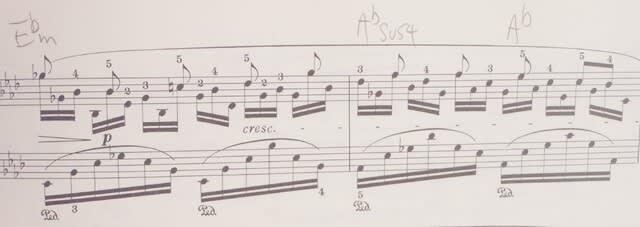tumblrにもUPしてるがyoutubeにUPするほどではないが自身の記録としておいておきたいもの
アドリブ練習や耳コピ練習中、昔弾いた曲の思い出し中・・的な動画のまとめ
こういう記録は自分でみかえしてみるといろいろと興味深いし役に立ったりする
《youtube~再生リストより》~限定公開動画~まとめ
tumblrにもUPしてるがyoutubeにUPするほどではないが自身の記録としておいておきたいもの
アドリブ練習や耳コピ練習中、昔弾いた曲の思い出し中・・的な動画のまとめ
こういう記録は自分でみかえしてみるといろいろと興味深いし役に立ったりする
《youtube~再生リストより》~限定公開動画~まとめ
ロックギターからクラシックピアノにアプローチしたので
クラシック音楽の楽譜にコードネームをふっていたら
知人のピアノ講師さんに不思議がられました(*⁰▿⁰*)



わたしはこの方がわかりやすい。。
いくつかのJ-pop弾いてみた動画を限定公開設定に
youtube→再生リスト→「J-pop cover/弾いてみた&練習」
追記:
youtubeへのジャンプリンク貼り付けがうまくいかず、
細かい場所へのジャンプ設定をしてもすべて最初のページにいってしまう
ここは2通りの弾き方が考えられる
ラクなのはⒶ、ギターテクニック向上を目指すならⒷ
There are two possible ways to play here.
The easy part is Ⓐ, but if you want to improve your guitar technique, Ⓑ
Ⓐ

Ⓑ

(※:ここのフレーズはアタマに休符があるので最初はダウンの空振りから始めて4弦9フレットはアップピッキングになる~以下同様)
The phrase here has a rest in the head, so the first rest is a down swing.
And the 4th string 9th fret is uppicking
~Same as below~
ここは
・まず3弦6フレットをチョーキングした状態でピッキング
・First, pick while bending the 3rd string and 6th fret.
・次にチョーキングダウンしてそのまま4フレットにプリング
Next, bend down and pull off to the 4th fret.
・・という連続技

ここは⇩このようなカタチにもできる
一見Ⓐのように3弦11フレットの後が休符に聴こえるがよく聴くと実はⒷのように4弦11フレットを弾いている
Here ⇩ It can also be shaped like this
At first glance, it sounds like there is a rest after the 11th fret of the 3rd string, as in Ⓐ, but if you listen closely, you'll actually see that the 11th fret of the 4th string is played, as in Ⓑ.
Ⓐ

Ⓑ

※:記事ラストに追記あり⇩
※:Ⓑのように2弦14→12フレットをプリングにする手段もある。その場合”薬指”でジャンプ!
There is also a way to pull-off from the 14th to 12th frets of the 2nd string, as in Ⓑ. In that case, jump with your ring finger!
まさに「C#7(-9)」のコードスケール!
コードの場所と関連付けて覚えておくと後々(様々な局面で)役に立つ
Exactly the chord scale of “C#7(-9)”!
It will be useful later (in various situations) if you remember it in association with the code location.

※《追加/addition》
・5弦ルートの”C#7”あたりでのポジション
Position around “C#7” of the 5th string root

・”C#7→F#m”(Ⅴ7→Ⅰm)と考えて「F#mのハーモニックマイナースケール」という覚え方もできる
If you think of “C#7→F#m” (Ⅴ7→Ⅰm)...It can also be thought of as a "harmonic minor scale of F#m"

・6弦ルートの”C#7”あたりのポジション2例
Two examples of positions around “C#7” of the 6th string root


フュージョン系の曲の場合コードを(アコギの弾き語りのように)全部弾くのではなく省略することが多い
In fusion songs, chords are often omitted rather than played entirely.
⇩例えばD9(#11)はルートを省略すると押さえやすくなる
For example, D9 (#11) will be easier to hold if you omit the root.
C7は7thの音をトップにもってくれば(その前後関係から)クリシェが作れる
With C7, you can create a "cliche" by bringing the 7th note to the top.

可能なテンションを加えるのは自由な発想なのでC7の時に「9th,#11th」を加えてD9(#11)と統一してもよい
Adding possible tension is a free idea, so you can add "9th, #11th" to C7 and unify it with D9 (#11).

・Bm7(-5)はこんなポジションで弾いてみたが・・
I tried playing Bm7(-5) in this position, but...

(🐱-5と♭5は同じこと、ついでに覚えよう🐱-5 and ♭5 are the same thing, let's remember that by the way.)
・探すといろいろ作れる(自分の好みを見つける作業は良いこと)
If you search, you can make a variety of things (finding what you like is a good thing)

《追記/postscript》
16ビートのコードカッティングのように「正確な順番で”ちゃんと”空振りを入れて」オルタネイトピッキングを
していると、ピッキングの微妙なニュアンスで(時として)ゴーストノート(ここでいう☆の音)が生まれることがある
Subtle nuances of picking can (sometimes) create ghost notes (the ☆ sounds here).

弾こうとしたがたまたま空振りしたケースもあれば、わずかにかすって小さい音になるケースもある
There are cases where I tried to play but ended up missing the shot, and other cases where the sound was slightly faint.
”このような休符”が含まれたフレーズを演奏する時は
When playing a phrase that includes such rests,

「弾こうとしてわざと空振りする」
・・のも「完コピ」のひとつの手段かもしれない..
"Make a mistake on purpose"
...That may be one of the techniques.
《関連記事/Related article》
本文中盤あたり~【弾き方の考察~Various ways to play..】~ゴーストノートについて(About Ghost Note)